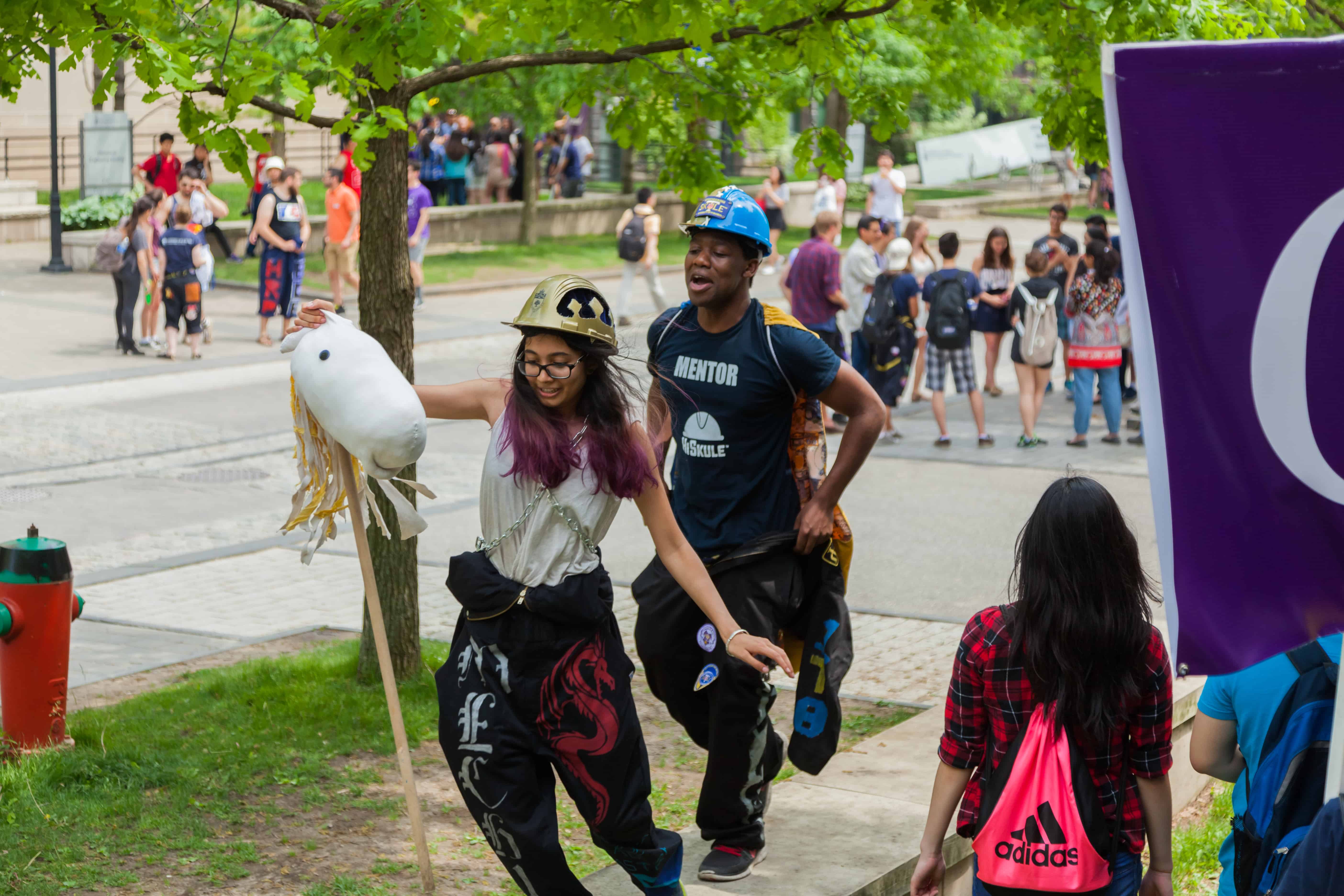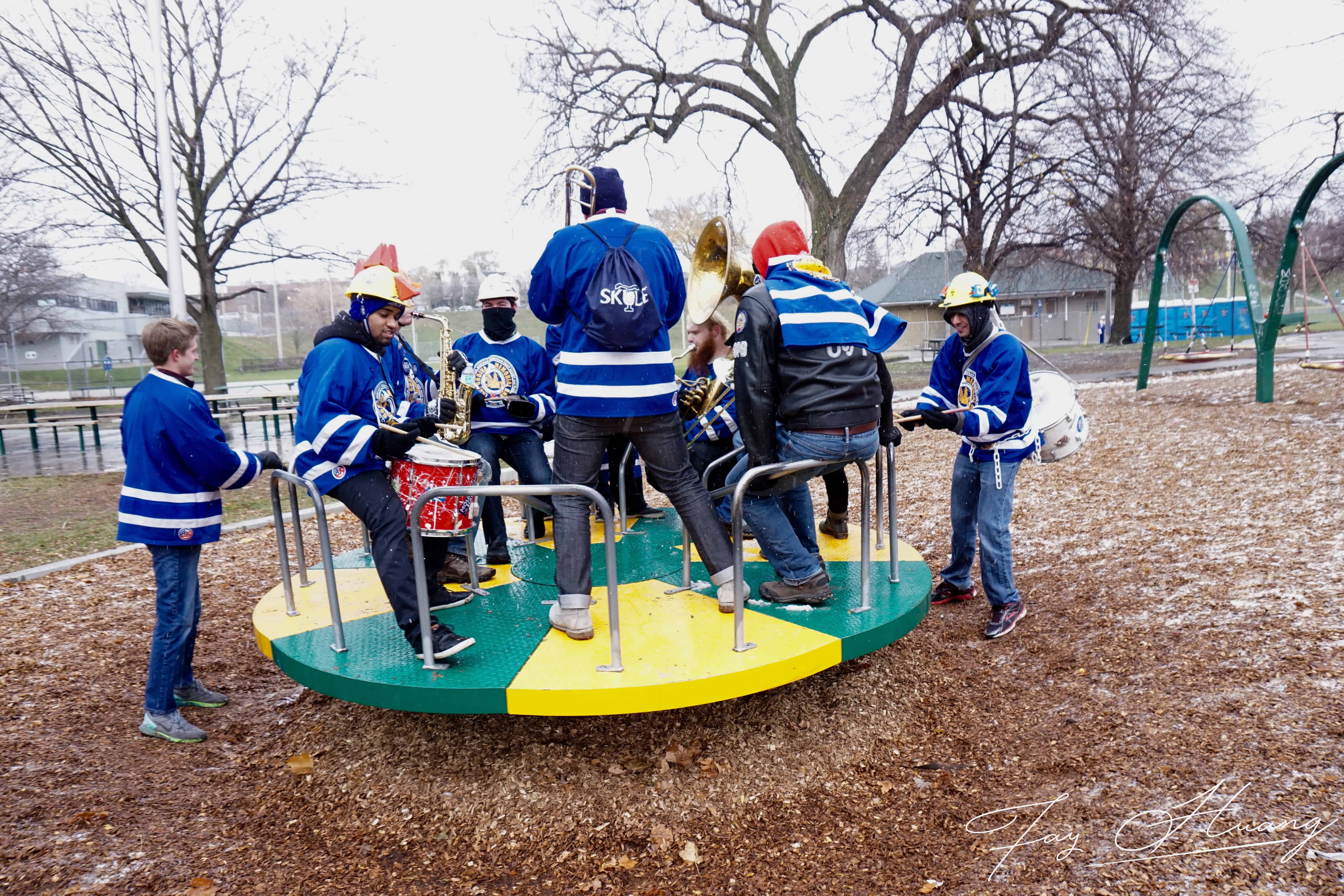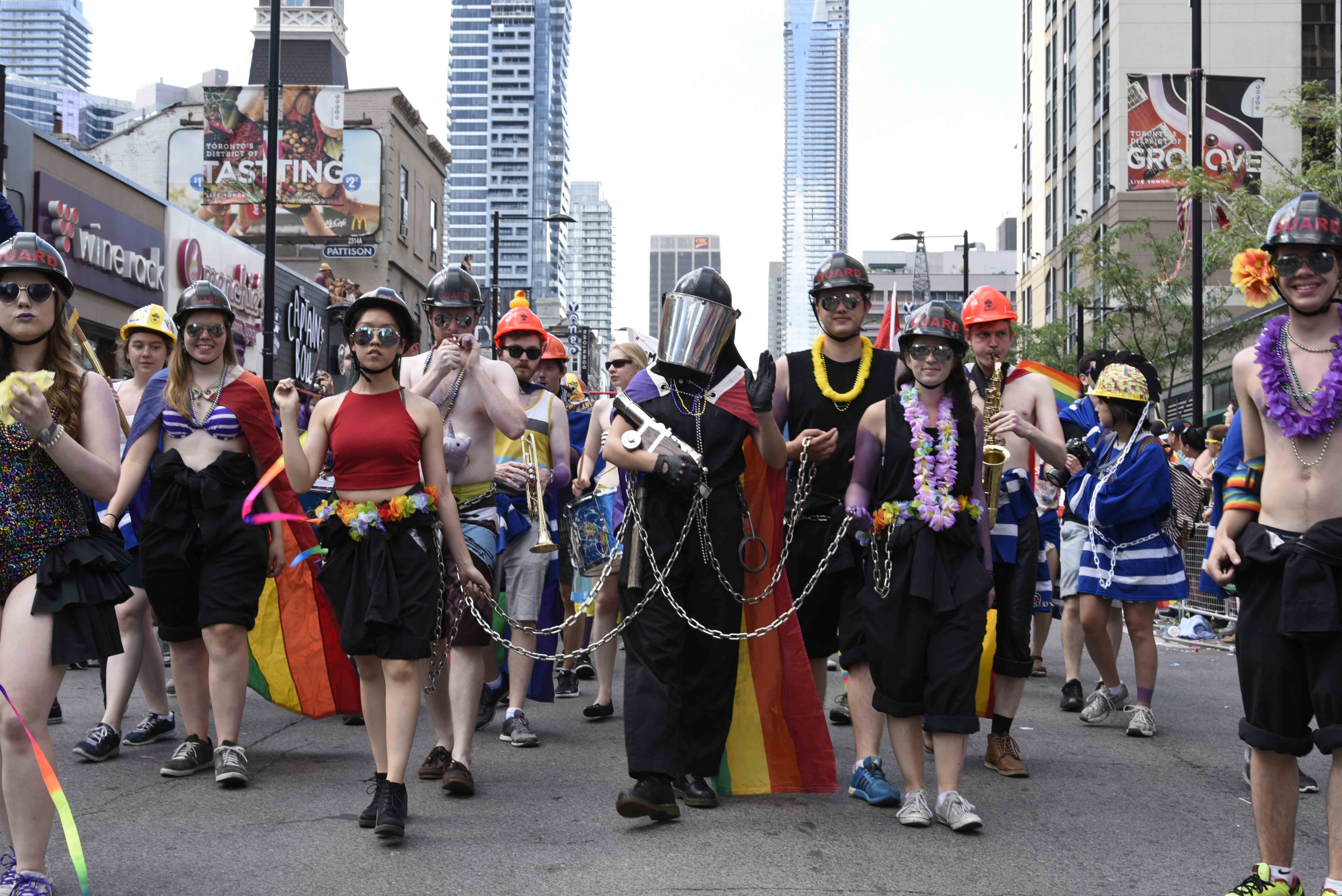It’s Not Rocket Science
Engineering is bringing traditions into the twenty-first century
By Andrew Kidd
Photo Credits
The Cannon Guard marching during the Toronto Pride Parade by Robert Goldberg
The Lady Godiva Memorial Bnad rehearsing prior to the Santa Claus parade by Fay Huang
The former Mr. Blue and Gold and Godiva’s Crown goofing around during Pre-Frosh by Oliver LaRose
[dropcap]U[/dropcap] of T Engineering is like a teenager moving away from home to attend its first year of university — while it seems identical to its old self on the outside, seismic changes are happening beneath the surface.
Outside observers see the same student-driven traditions, the separate set of courses in mathematics and science, and the independence from U of T’s college system. While these inertial aspects of U of T Engineering remain, students and faculty alike are working to redefine the engineering experience, particularly for women and first-year students.
Gender diversity
Engineering, as a profession and as a division of U of T, has long struggled with a past littered with sexism and misogyny. Whether in the shiny workplaces of Silicon Valley or the grungy environment of a manufacturing plant, women have long been made to feel unwanted.
The Faculty of Applied Science and Engineering and its students have worked to foster a more welcoming culture and attract female students to the field of engineering. Their effort has been met with some success: the U of T class of 2018 set an Ontario record when women made up 30.6 per cent of students. That record was smashed by the class of 2020, where more than 40 per cent of students are female.
The faculty has launched outreach programs to connect directly with potential female applicants, promoting both engineering and U of T. Ranging from overnight experiences like Girls’ Leadership in Engineering Experience (GLEE) to educational sessions like the Young Women in Engineering Symposium or Go CODE Girl, these programs have been cited by many female students as a key factor in their decision to join U of T Engineering.
Third-year Mechanical Engineering student Julia Filiplic said, “[GLEE] shows you what you can do, both while you’re at school and once you’ve graduated.”
Jason Foster, Associate Professor of Engineering Design, Teaching Stream, said the success of programs like GLEE is attributable to the “community and shared set of experiences… and the connections and network between students.”
At the same time, the broader community of engineering students has been working to bring engineering culture into the twenty-first century by opening up spirit positions that are traditionally held by men, like the Chief Attiliator of Ye Olde Mighty Skule Cannon, to women. It has also welcomed non-binary individuals into roles that were originally gendered, like Godiva’s Crown.
David Boroto, a third-year Engineering Science Infrastructure student who served as Mr. Blue & Gold 2016, highlighted the importance of this diversification because, as he sees it, people feel welcomed and included when they see others like them who are actively engaged in the engineering community.
Despite these efforts, significant obstacles remain. Filiplic reports having had a few negative experiences attributable to her gender. While isolated, these incidents are still deeply concerning.
“Because in some of those cases, it’s easy to be like, ‘I’m gonna dismiss you as an emotional girl,’ because girls are sometimes known to be more emotional, so you have to be like in the know and be ready with multiple defenses,” Filiplic said.
Fortunately, students have used these incidents as opportunities to engage each other in conversation around these issues, while also spurring the faculty to take action.
Foster said that in teaching, “We’ve deliberately, in our modeling of behaviour, said this isn’t about… socially-normed gender roles, it’s about everybody in the class getting in there… regardless of gender or ethnicity… we’re shooting for equality of opportunity to engage.”
First-year inclusion
Similarly, students have driven change and improvement in the experiences of those entering the faculty in first year.
As the student body becomes more diverse, changes to F!rosh Week have included banning cheers and chants tinged with misogyny, and more subtle alterations like removing an event involving students busking for donations from the public.
Events like the Charity Buskerfest were often uncomfortable and unwelcoming for students, particularly for those from cultures that frown upon asking strangers for money.
Of course, these changes have not diluted the enthusiasm of engineering students expressed during F!rosh Week. Today’s F!rosh Week is every bit as fun and engaging as those of the past, while it still upholds a culture of openness and inclusivity to all.
Jinansh Shah, first-year student in Engineering Science, said, “It was definitely inclusive, all the Frosh leedurs were definitely hyped and encouraged the frosh to be hyped and have some Skule spirit, even though we were kind of new to everything.”
Foster confirmed that sentiment, saying that students can opt out of any events that make them feel uncomfortable and find much more support in those choices than in the past.
F!rosh Week concludes with an academic orientation delivered by the departments within the faculty, introducing students not only to the content they will be seeing, but also to the support system built around them.
In the last 20 years, the faculty has ensured that every student in engineering has access to academic advisors, as well as engineering-specific experts in counselling and psychotherapy, learning skills development, and international student transitions.
Staff in the faculty’s First Year Office work to integrate these disparate elements of support into a unified system for students as they adjust to life at university.
First-year students are also guided in their acclimatization through Orientation to Engineering, a mandatory course for most engineering students. The course presents students with information on how to find success in engineering. As a pass/fail course, it also encourages students to focus on understanding and appreciating the course content, rather than fixating purely on a numerical mark.
Students report that these efforts have largely been successful: Shah describes the system as responsive to students and effective at directing students to the specific support they need.
All this serves to communicate to both first-year students and women in engineering of the community’s dedication to inclusivity. From the clear increase in women enroled alone, the results are real and tangible.
The former Mr. Blue and Gold and Godiva’s Crown goofing around during Pre-Frosh taken by Oliver LaRose

The Explainer:
Engineering traditions
Skule
Before becoming part of the University of Toronto, the Faculty of Applied Science and Engineering was known as the School of Practical Science. Playing on stereotypes about engineers’ lack of spelling ability, students christened their community ‘Skule,’ instead of ‘School.’
Ye Olde Mighty Skule Cannon
The Skule Cannon, a custom-made miniaturized cannon that produces a very loud noise when fired, is the mascot of the U of T Engineering community. The cannon is protected by the Chief Attiliator, a respected member of the Skule community whose identity is kept secret. The Attiliator is helped by student Cannon Guards, who undergo training to ensure the safety of those near the cannon. The cannon is a symbol designed to unite engineering students, inspired by their success in keeping it secure against attempted theft from groups within U of T and other universities.
Lady Godiva Memorial Bnad
Again playing on stereotypes about spelling, the Lady Godiva Memorial Bnad (LGMB), is a band open to all engineering students, spreading Skule spirit with noise and, occasionally, music. The LGMB is the most inclusive Skule tradition, designed as an outlet for anyone to be able to represent Skule, no matter regular involvement or musical ability.
Purple dye
Engineers dye themselves purple during F!rosh Week to pay tribute to army engineers during the Second World War, whose purple armbands bled dye onto their arms as they worked to build bridges in the liberation of Holland.
Mr. Blue & Gold
Mr. Blue & Gold is a leader of Skule spirit and a mascot of U of T Engineering’s spirit group, the Blue & Gold Committee. They swear an oath to drop their pants whenever asked by another member of the Skule community, in order to bring the engineering community together.
Godiva’s Crown
Another mascot of the Blue & Gold Committee, Godiva’s Crown symbolizes the engineers’ embrace of the legend of Lady Godiva, an English noblewoman who sacrificed her dignity for the common good. As a leader of Skule spirit, Godiva’s Crown swears an oath to click their heels whenever asked by another member of the Skule community.
The Lady Godiva Memorial Bnad rehearsing prior to the Santa Claus parade taken by Fay Huang



